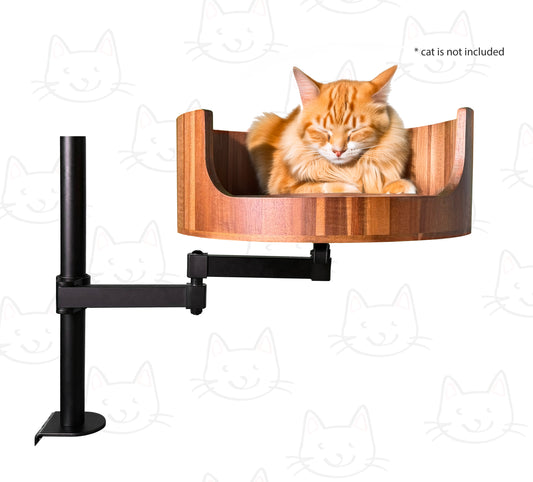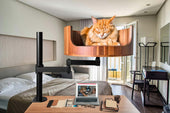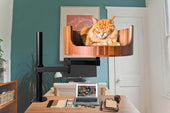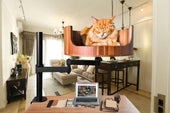
Cats with More Than 5 Toes: A Unique Feline Trait
Share
Desk Cat Nest is a breeding ground for unique felines with a special trait: more than five toes on their paws. While polydactyl cats, as they are scientifically known, are not unheard of, the cats at Desk Cat Nest possess an unusually high number of toes, making them truly one-of-a-kind. This rare genetic trait has fascinated researchers and cat enthusiasts alike, leading to the discovery of some fascinating characteristics and behaviors unique to these extra-toed felines.
In this article, we will delve into the world of polydactyl cats at Desk Cat Nest, exploring the genetics behind their extra toes and the impact it has on their overall health and well-being. We will also discuss the history of polydactyl cats and how they have been revered and celebrated in various cultures throughout the years. Additionally, we will highlight some of the famous polydactyl cats that have captured the hearts of people around the world, showcasing the special bond that can form between humans and these remarkable felines. Join us on a journey into the fascinating world of cats with more than five toes, where each paw tells a unique story of genetic diversity and feline charm.
1. Polydactyl cats, or cats with more than the usual number of toes, are unique due to a genetic mutation that causes extra digits.
2. Ernest Hemingway's love for these cats led to their popularity in the Florida Keys, where many descendants of his polydactyl cat, Snowball, still roam.
3. Polydactyl cats are often referred to as "Hemingway cats" and are known for their friendly and sociable nature.
4. While polydactyly can occur in any breed, it is most commonly seen in Maine Coons and American Shorthairs.
5. Their extra toes give polydactyl cats a distinctive look and have made them a beloved and cherished feline trait.
## The Genetic Basis of Polydactylism in Cats
Polydactylism, the condition in which a cat has more than the standard number of toes, is a genetic trait that is passed down through generations. This trait is caused by a mutation in a specific gene that regulates the development of the limbs during fetal growth. While most cats have five toes on their front paws and four on their back paws, polydactyl cats can have up to seven toes on each paw. This genetic variation can occur in any breed of cat but is more commonly seen in certain breeds such as Maine Coons and American Shorthairs.
## Historical Significance of Polydactyl Cats
Polydactyl cats have a long history of being admired and revered by many cultures around the world. In early maritime communities, polydactyl cats were believed to bring good luck to sailors and fishermen, leading to their popularity on ships and in port towns. One of the most famous examples of a polydactyl cat is "Snowball," a beloved feline resident of Ernest Hemingway's home in Key West, Florida. Hemingway was so enamored with Snowball and her descendants that he referred to them as "Hemingway cats" and reportedly allowed them to freely roam his property.
## Unique Advantages of Having More Than 5 Toes
Polydactyl cats are known for their unique physical traits, including their extra toes, which can provide certain advantages in terms of dexterity and balance. Cats with more toes may have enhanced gripping ability, making them better at climbing and hunting. Additionally, the extra toes can act as a sort of natural snowshoe, providing better traction in snowy or icy conditions. In some cases, polydactyl cats have even been known to excel in activities such as opening doors or manipulating objects with their extra toes, showcasing their exceptional hand-eye coordination.
## Ethical Considerations and Health Implications
While polydactylism in cats is generally considered a harmless genetic variation, there are some potential health implications to be aware of. Cats with excessively large or malformed extra toes may experience mobility issues or discomfort, especially as they age. It is essential for cat owners of polydactyl cats to monitor their pet's health closely and consult with a veterinarian if any issues arise. Additionally, some animal welfare organizations have raised concerns about the breeding of polydactyl cats for novelty purposes, as this could perpetuate harmful genetic mutations or lead to an overpopulation of cats with special needs.
Frequently Asked Questions
Can cats with more than 5 toes use the Desk Cat Nest?
Yes, cats with more than 5 toes can still comfortably use the Desk Cat Nest. The spacious design and soft cushion make it a perfect resting spot for any cat, regardless of the number of toes.
Is the Desk Cat Nest durable enough for cats with more than 5 toes?
Yes, the Desk Cat Nest is made of high-quality materials that are durable and sturdy enough to support cats with more than 5 toes. Your cat can enjoy lounging in this nest without any worries of it breaking or wearing down easily.
Will cats with more than 5 toes feel comfortable in the Desk Cat Nest?
Absolutely! The Desk Cat Nest is designed with the comfort of all cats in mind, including those with more than 5 toes. The soft cushion and spacious layout provide a cozy environment for your cat to relax and nap in.
Can cats with more than 5 toes easily access the Desk Cat Nest?
Yes, the Desk Cat Nest is designed to be easily accessible for cats of all sizes and shapes, including those with more than 5 toes. The low entry point and sturdy construction make it simple for your cat to enter and exit the nest whenever they please.
In conclusion, the Desk Cat Bed is a valuable choice for cats with more than 5 toes due to its innovative design that provides extra space and comfort for their unique needs. This specialized bed allows these polydactyl cats to stretch out and relax without feeling cramped or restricted. With its cozy and secure design, the Desk Cat Bed offers a safe and inviting space for these special felines to rest and play, promoting their overall well-being and happiness. Choose the Desk Cat Bed for your polydactyl cat and treat them to the ultimate in comfort and luxury.



















































